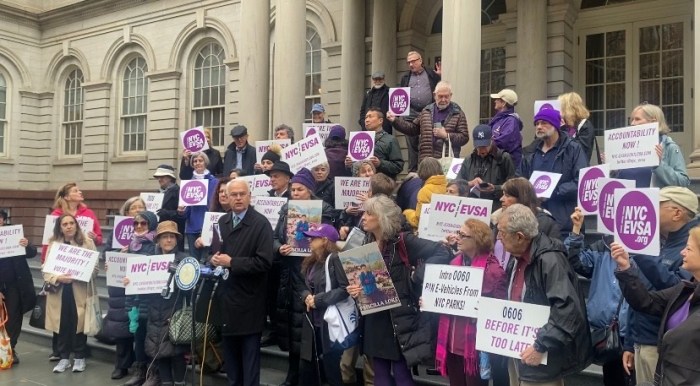By Kenneth Kowald
Hold on! This is not a story about a dirty old man. This is about horseshoe crabs.On a late May afternoon last year I joined about 50 other adults and students on a walk to observe the horseshoe crab and its mating habits. We started from the Plum Beach rest stop on the Belt Parkway and spent about two hours exploring the area.The event, sponsored by the Environmental Education Advisory Council, was led by Alan Ascher. I have known and respected Ascher for many years. He has been an outstanding science teacher in the New York City schools and is now an assistant principal of a high school on Staten Island. He has been leading these walks for years, but I never “got 'round” to joining them until last spring.Not only did Ascher give us a history of this more than 360 million-year-old species, but he gave a most informative talk about the area we walked through and about its geological history and its history in modern times. It is part of the Gateway National Recreation Area, which includes parts of Queens.Each spring, the horseshoe crabs come ashore to lay their eggs at the high tide line. These provide food for migrating shorebirds arriving in New York City.One of the facts we learned was that most of the litter we saw along the shoreline was not left by visitors, but was brought in by the tides. Ascher rightly asked people on the walk to come with litter bags to help police the area.The American Horseshoe Crab is a unique and valuable marine invertebrate which provides ecological and economic benefits through the Mid-Atlantic region. In parts of the region, watermen harvest the crabs as bait to catch several commercial fish species, including eel and whelk.But perhaps the most important thing to know about horseshoe crabs is that for the past 40 years their white blood cells have been used to detect endotoxins, because these would clot when exposed to minute traces of gram-negative bacteria. This material, known LAL, is used in the drug industry as the most sensitive and cost-effective test for finding endotoxins in intravenous solutions.And the best part of this is that the vast majority of the crabs used for this purpose are able to survive.Clearly, this is a fascinating creature.And you can learn about it on at least three occasions this spring. On Monday, May 23, the National Park Service and the Littoral Society will lead a walk beginning at 7:30 p.m. starting from the North Channel Bridge, Howard Beach, at the Jamaica Wildlife Center; call 718-318-4340 because space is limited and bring a flashlight for this night walk, which Alan Ascher says adds to the excitement. On Wednesday, May 25, from 4 p.m. to 6:30 p.m., Ascher will lead another EEAC-sponsored walk along Plum Beach; call Barry Weinbrom at 718-965-9814 or write to alanascher@aol.com. On Monday, June 6, beginning at 11:30 a.m., the Alley Pond Environmental Center will lead a walk along Little Neck Bay; call 718-229-4000.Enjoy the walk!(Update: In a recent column on the Queens Botanical Garden, I mentioned the annual Arbor Day celebration. It will be held this year on Friday, May 6, beginning at 10 a.m. This is a good time to enjoy the beauty of the garden and to see how effectively it is used as an educational destination. I have written a few times about the need for “greening” Atlantic Avenue between the Brooklyn border and the Van Wyck Expressway. Dorothy Lewandowski, Queens Parks commissioner, tells me 40 street trees will be planted along this stretch this spring. Thank you, commissioner. Tree plantings on the medians are not possible because the Long Island Rail Road runs beneath the medians. I would hope, however, that plantings of some kind can be done on the medians. After all, trains run beneath Park Avenue and upper Broadway in Manhattan, but there is greening on those thoroughfares. Let us hope something like that can be done for Atlantic Avenue. It could use it.)

































